Use Cases
Advanced NHDPlus Network Attributes
Keywords: hydrography; mainstems; reference fabric
Domain: Hydrology
Language: R
Description:
Summary of NHDPlus network attributes that are central to the reference fabric, NLDI, and NHDPlus data model generally. Highlights the nhdplusTools package as well as the NHD data use in many aspects of the NHGF
Linked Catalog Datasets:
- E2NHDPlusV2_us: Database of Ancillary Hydrologic Attributes and Modified Routing for NHDPlus Version 2.1 Flowlines
- NHDPlus v2: National Hydrography Dataset Plus version 2
- National Water Model V2.1 retrospective for selected NWIS gage locations, (1979-2020)
- Updated CONUS river network attributes based on the E2NHDPlusV2 and NWMv2.1 networks
- Mainstem Rivers of the Conterminous United States (ver. 2.0, February 2023)
Linked Catalog Tools:
Introduction
Water quantity and quality models adopt network connectivity from hydrographic datasets as a given – it’s imperative that we seek to improve the networks in our reference hydrographic datasets to minimize basic network errors in our models. When issues with hydrographic datasets are identified and fixed, there is a need to regenerate attributes based on some aspect of network connectivity (total drainage area for example). This use case summary describes how a suite of attributes from the NHDPlus data model can be recalculated.
Tools
- hydroloom : hydroloom is a collection of functions to work with hydrologic geospatial fabrics.
- nhdplusTools
: R tools for
traversing and working with National Hydrography Dataset Plus
(NHDPlus) data.
nhdplusToolsuses the more more generalhydroloompackage for most of the work demonstrated here.
Data
- NHDPlusV2 : National hydrographic dataset including elevation derived catchments and many value added attributes.
- E2NHDPlusV2_us : Quality controlled and updated network connectivity for the NHDPlusV2 from the National Water Quality Assessment.
- NWMv2.1 : Quality controlled and updated network connectivity for the NHDPlusV2 from the National Weather Service National Water Model.
- Resulting Reference Network : Output of work summarized here and in https://doi.org/10.1016/j.envsoft.2023.105726 .
Data Preparation
The updated network connectivity in the NWMv2.1 and ENHDPlusV2_us are, by in large, connections where no connection exists in the NHDPlusV2 or changes to dominant path (main path vs divergence) respectively. Given these two classes of updates, the attribute indicating the next downstream flowline is the only attribute updated for the work described here. Further details of this process of updating NHDPlusV2 attributes with changes found in the two sources of quality control is beyond the scope of this use case summary.
The full workflow described here is contained in the mainstems project repository . For the purposes of this demonstration, a subset of the data in question was generated.
Background
The NHDPlus data model includes many ‘value added attributes’ (VAAs).
This use case discusses a core set of VAA’s that nhdplusTools and
hydroloom can create from readily available hydrograhic inputs. It
begins with a background needed to understand what these attributes are,
then demonstrates how to create them based on the updated nhdplus
attributes described above. These attributes are documented in the
NHDPlus
manual
,
and every effort has been made to faithfully implement their meaning.
While the nhdplusTools and hydroloom packages contains other
functions to generate network attributes, (such as Pfafstetter codes and
stream order) this vignette focuses on the network VAAs from the NHDPlus
data model that revolve around the hydrosequence and levelpath
attributes.
Terminology
The terms used below are derived from concepts of graph theory , the HY_Features data model, and the NHDPlus data model. Many of the concepts here are also presented in two journal aticles: Mainstems: A logical data model implementing mainstem and drainage basin feature types based on WaterML2 Part 3: HY Features concepts and Generating a reference flow network with improved connectivity to support durable data integration and reproducibility in the coterminous US .
Representing Network Topology
A network of flowpaths can be represented as an edge-to-edge (e.g. edge list) or edge-node topology. An edge list only expresses the connectivity between edges (flowpaths in the context of rivers), requiring nodes (confluences in the context of rivers) to be inferred.
As of 9/2023 nhdplusTools works on edge list representations only and,
the still provisional, hydroloom has some support for edge-node
topology. The table and simple graphics below depict both an edge-node
and edge-to-edge topology.
#> id toid fromnode tonode
#> 1 3 N1 N3
#> 2 3 N2 N3
#> 3 NA N3 N4
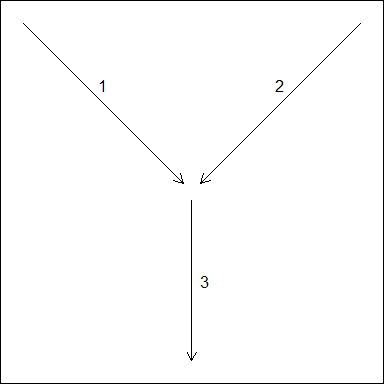
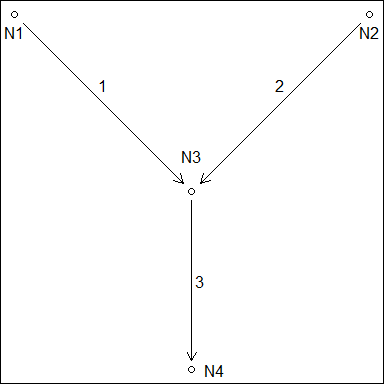
In an edge-node topology, edges are directed to nodes which are then directed to other edges. An edge-to-edge toplogy does not have intervening nodes.
The “toid” of a terminal flowpath can be either NA or, by convention, 0.
Using 0 is preferred within nhdplusTools but both are handled in most
cases. Further, as long as 0 is not in the set of ids, there is little
practical difference.
In nhdplusTools, edge-to-edge topology is referred to with “comid and
tocomid” attributes, or a more general, “id and toid” depending on the
function in question.
Hydrosequence
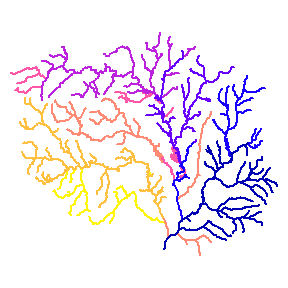
Smaller ‘hydrosequence’ values are guaranteed to be downstream of larger values along connected paths.
The NHDPlus data model includes an attribute called hydrosequence that
is functionally a
topological
sort
of the flowpath
network. It provides an integer identifier guaranteed to decrease in the
downstream direction. For flowpaths that are not connected by a single
direction navigation (e.g. parallel tributaries) the hydrosequence has
no significance. However, when two flowpaths have a direct navigation,
the downstream flowpath will always have the smaller hydrosequence.
nhdplusTools supports creation of hydrosequence with the
get_sorted() function.
It is hard to overstate the importance of hydrosequence as any
function that requires understanding upstream-downstream relationships
requires a sorted version of the flowpath network. In the NHDPlus data
model, a edge-list topology is stored in the form of a hydrosequence and
‘to hydrosequence’ attribute. The equivalent is available in
nhdplusTools, but does not use the to hydrosequence convention,
preferring the primary identifier (id or comid) and an accompanying
toid/tocomid.
Level Path
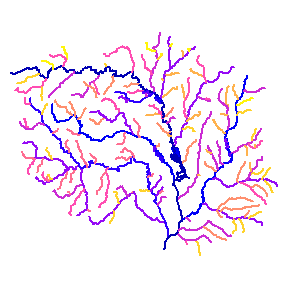
Levelpath values are constant along mainstem paths and are derived from the hydrosequence of their outlet flowline.
A level path is derived from “stream level” which assigns an integer value to mainstem rivers from outlet up the network (see NHDPlus documentation for more). Rivers terminating to the ocean are given level 1 and this level extends all the way to the headwaters. Rivers terminating in level 1 rivers are given level 2, and so on.
“Stream leveling”, then, is the process of establishing uniquely
identified “level paths” through a stream network. This is accomplished
with a set of rules that determine which tributary should be considered
dominant at every confluence to establish the “mainstem rivers” for each
“drainage basin” in a network. nhdplusTools supports creation of
streamlevel with the get_streamlevel() function, and the creation of
level path with get_levelpath(). The convention used in NHDPlus is to
assign the levelpath as the hydrosequence of the path’s outlet.
See Mainstems: A logical data model implementing mainstem and drainage basin feature types based on WaterML2 Part 3: HY Features concepts for an in depth discussion of these concepts.
Other Derived Network Attributes
A number of additional attributes can be derived once levelpath and
hydrosequence are established. These include:
- terminal path (
terminalpa): the identifier (hydrosequence or primary id) of the terminal flowpath of network. - up hydrosequence (
uphydroseq): the identifier of the upstream flowpath on the mainstem - down hydrosequence (
dnhydroseq): the identifier of the downstream flowpath on the mainstem - up level path (
uplevelpat): the identifier of the next upstream levelpath on the mainstem - down level path (
dnlevelpat): the identifier of the next downstream levelpath on the mainstem - path length (
pathlength): The distance to the network outlet downstream along the main path. - total drainage area (
totdasqkm): Total accumulated area from upstream flowpath’s catchment area. - arbolate sum (
arbolatsu): The total accumulated length of upstream flowpaths. - terminal flag (
terminalfl): A simple 0 or 1 indicating whether a flowpath is a terminal path or not.
Required Base Attributes
Creating levelpath and hydrosequence identifiers requires a set of base attributes that include:
fromnode/tonodeorid/toid: from and to nodes can be used to generate an edge to edge flowpath topology. Note that “id/toid” is “comid/tocomid” in somenhdplusToolsfunctions.length: a length is required for each flowpath in the network to determine a flow distance, and, if using the arbolate sum for stream leveling.area: the local drainage area of each flowpath is useful in many contexts but is primarily used to calculate total drainage area.weight: a weight metric is required for stream leveling to determine the dominant upstream flowpath. In the NHD, the arbolate sum is used however alternative metrics (e.g. total drainage area) can be used instead.nameid: Many times it is preferable to follow a consistently named path (e.g. GNIS) rather a strict physical weight when stream leveling. In these cases anameidcan be provided.divergence: in order to create a [many:1] upstream to downstream topology, diverted paths must be labeled as such. This attribute, is 0 for normal (already [many:1]) connections, 1 for the main path through a divergence, and 2 for any diverted path.feature type (
ftype): used to determine whether a feature is a stream, a coastal path, or some other type of connected network feature. This is the ‘ftype’ in the NHD data model.
NOTE: The nhdplusTools package does not support creation of all
attributes discussed here, however, those that are not directly
supported can be created based on basic transformations of attributes
that nhdplusTools does support.
A visual introduction to the advanced network attributes
To illustrate the above concepts and attributes, we’ll start with the
“New Hope” demo data included in the nhdplusTools package and add a
tocomid attribute based on the edge-node topology included in the data.
# Import data
source(system.file("extdata/new_hope_data.R", package = "nhdplusTools"))
# Strip the data back to the required base attributes
fpath <- get_tocomid(
dplyr::select(new_hope_flowline, COMID, FromNode, ToNode, Divergence, FTYPE,
AreaSqKM, LENGTHKM, GNIS_ID)
)
# Print
head(fpath <- select(sf::st_cast(fpath, "LINESTRING"),
-tonode, -fromnode, -divergence, -ftype))
#> Simple feature collection with 6 features and 5 fields
#> Geometry type: LINESTRING
#> Dimension: XY
#> Bounding box: xmin: 1517192 ymin: 1555954 xmax: 1518819 ymax: 1557990
#> CRS: +proj=aea +lat_1=29.5 +lat_2=45.5 +lat_0=23 +lon_0=-96 +x_0=0 +y_0=0 +ellps=GRS80 +towgs84=0,0,0,0,0,0,0 +units=m +no_defs
#> # A tibble: 6 × 6
#> comid tocomid areasqkm lengthkm gnis_id geom
#> <int> <dbl> <dbl> <dbl> <chr> <LINESTRING [m]>
#> 1 8893864 8894334 4.81 3.24 991288 (1518702 1557298, 1518643 1557297, …
#> 2 8894490 8894336 0 0.002 991288 (1517194 1556000, 1517192 1555999)
#> 3 8894494 8894490 0.009 0.102 991288 (1517288 1556038, 1517252 1556023, …
#> 4 8894334 8894492 0.428 0.073 991288 (1517349 1556090, 1517341 1556077, …
#> 5 8894492 8894494 0.0018 0.008 991288 (1517295 1556041, 1517288 1556038)
#> 6 8893850 8893864 0.406 0.954 991288 (1518668 1557990, 1518699 1557904, …
Hydrosequence and terminal id
After removing attributes used to generate the tocomid attribute, we
have a comid and tocomid relation representing the connectivity of
the network as well as attributes required to generate a sorted network
with get_sorted()
head(fpath <- get_sorted(fpath, split = TRUE))
#> Simple feature collection with 6 features and 6 fields
#> Geometry type: LINESTRING
#> Dimension: XY
#> Bounding box: xmin: 1505349 ymin: 1554873 xmax: 1508920 ymax: 1558708
#> CRS: +proj=aea +lat_1=29.5 +lat_2=45.5 +lat_0=23 +lon_0=-96 +x_0=0 +y_0=0 +ellps=GRS80 +towgs84=0,0,0,0,0,0,0 +units=m +no_defs
#> # A tibble: 6 × 7
#> comid tocomid areasqkm lengthkm gnis_id terminalID geom
#> <int> <dbl> <dbl> <dbl> <chr> <int> <LINESTRING [m]>
#> 1 8898302 8896658 0.152 0.182 "98382… 8897784 (1505349 1555718, 150545…
#> 2 8896658 8896656 1.19 1.37 "98382… 8897784 (1505455 1555570, 150547…
#> 3 8896656 8896624 3.86 2.64 "98382… 8897784 (1506375 1554873, 150644…
#> 4 8896664 8896624 1.38 1.64 " " 8897784 (1507786 1554903, 150781…
#> 5 8896624 8896570 1.34 1.17 "98382… 8897784 (1508236 1556343, 150825…
#> 6 8896572 8896570 1.56 1.77 " " 8897784 (1508311 1558708, 150835…
The get_sorted() function sorts the flowpaths such that headwaters
come first and the terminal flowpath last. Additionally, it produces a
terminalID representing the outlet id of the network. If multiple
terminal networks had been provided, the terminalID would allow us to
group the data by complete sub networks (a convenient parallelization
scheme).
In contrast to the NHD, where the terminal path is identified by the
hydrosequence id of the outlet flowpath (meaning the outlet of a level
path is left to a user to generate), nhdplusTools uses the more stable
primary id for identifying outlets to allow the hydrosequence / topo
sort attribute to be generated and discarded as needed.
We can visualize this sorting by assigning a temporary “hydrosequence” value to the sorted network row wise. Here, we assign the first rows in the sorted set to large values and the last rows to small values in line with the hydrosequence order convention in NHDPlus.
fpath['hydrosequence'] <- seq(nrow(fpath), 1)
plot(fpath['hydrosequence'], key.pos = NULL)

Level Path and outlet id
To generate a levelpath attribute, a “physical” weight is needed to
determine the upstream mainstem at divergences. For this example, we’ll
follow the NHD convention and calculate the arbolate sum explicitly. The
get_levelpaths() function will add arbolate sum internally if no
weight is explicitly defined.
# Rename and compute weight
fpath[["arbolatesum"]] <- calculate_arbolate_sum(
dplyr::select(fpath,
id = comid, toid = tocomid, length = lengthkm))
plot(sf::st_geometry(fpath), lwd = fpath$arbolatesum / 10)

A nameid identifier can also be provided to override the physical
weight when a “smaller” river has the same name. There is an optional
override_factor parameter that signifies if the physical weight is
override_factor times (e.g. 5) larger on an unnamed or differently
named upstream path, the physical weight will be used in favor of the
named id.
As mentioned above, nhdplusTools favors more general naming of to/from
nodes then the NHD, so names are modified accordingly.
# Get levelpaths
lp <- get_levelpaths(
dplyr::select(fpath,
ID = comid, toID = tocomid,
nameID = gnis_id, weight = arbolatesum),
status = FALSE, override_factor = 5)
#> Loading required namespace: future
#> Loading required namespace: future.apply
# Print
head(fpath <- dplyr::left_join(fpath, lp, by = c("comid" = "ID")))
#> Simple feature collection with 6 features and 11 fields
#> Geometry type: LINESTRING
#> Dimension: XY
#> Bounding box: xmin: 1505349 ymin: 1554873 xmax: 1508920 ymax: 1558708
#> CRS: +proj=aea +lat_1=29.5 +lat_2=45.5 +lat_0=23 +lon_0=-96 +x_0=0 +y_0=0 +ellps=GRS80 +towgs84=0,0,0,0,0,0,0 +units=m +no_defs
#> # A tibble: 6 × 12
#> comid tocomid areasqkm lengthkm gnis_id terminalID geom
#> <int> <dbl> <dbl> <dbl> <chr> <int> <LINESTRING [m]>
#> 1 8898302 8896658 0.152 0.182 "98382… 8897784 (1505349 1555718, 150545…
#> 2 8896658 8896656 1.19 1.37 "98382… 8897784 (1505455 1555570, 150547…
#> 3 8896656 8896624 3.86 2.64 "98382… 8897784 (1506375 1554873, 150644…
#> 4 8896664 8896624 1.38 1.64 " " 8897784 (1507786 1554903, 150781…
#> 5 8896624 8896570 1.34 1.17 "98382… 8897784 (1508236 1556343, 150825…
#> 6 8896572 8896570 1.56 1.77 " " 8897784 (1508311 1558708, 150835…
#> # ℹ 5 more variables: hydrosequence <int>, arbolatesum <dbl>, outletID <int>,
#> # topo_sort <int>, levelpath <dbl>
plot(fpath["topo_sort"], key.pos = NULL, reset = FALSE)
plot(fpath["levelpath"], key.pos = NULL)
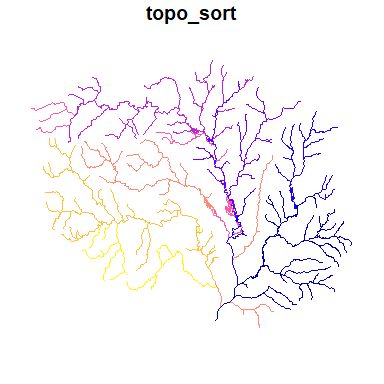
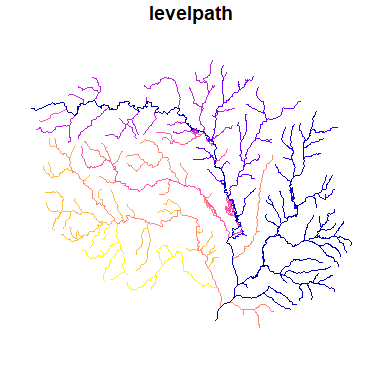
Note that the get_levelpaths adds an outletID signifying the overall
network outlet id (not topo sort / hydrosequence) by primary identifier.
Finally, let’s visualize these advanced VAAs!
In the below animation, each newly added level path is shown in blue,
with the outlet flowpath colored in red. Remembering that get_sorted()
sorts flowpaths such that headwaters come first and the terminal
flowpaths last we invert the network so that level paths fill in from
outlet to head waters. For clarity, only levelpaths with more than 2
flowlines are shown.
# Invert plotting order
fpath <- dplyr::arrange(fpath, topo_sort)
# Level Paths with more then 2 flowpaths
lp <- dplyr::group_by(fpath, levelpath) %>%
dplyr::filter(n() > 2)
# Unique Level Path id
lp <- unique(lp$levelpath)
# Terminal Flowpath
terminal_fpath <- dplyr::filter(fpath, comid %in% terminalID)
gif_file <- "levelpath.gif"
gifski::save_gif({
for(i in 1:length(lp)) {
lp_plot <- dplyr::filter(fpath, levelpath == lp[i])
outlet_plot <- dplyr::filter(lp_plot, comid %in% outletID)
plot(sf::st_geometry(fpath), lwd = 0.5, col = "grey")
plot(sf::st_geometry(terminal_fpath), lwd = 3, col = "red", add = TRUE)
plot(sf::st_geometry(dplyr::filter(fpath, levelpath %in% lp[1:i])), add = TRUE)
plot(sf::st_geometry(lp_plot), col = "blue", add = TRUE)
plot(sf::st_geometry(outlet_plot), col = "red", lwd = 1.5, add = TRUE)
}
}, gif_file, delay = 0.5)
#> [1] "C:\\Users\\dblodgett\\active_code\\nhgf_static_catalog\\content\\usecase-examples\\advanced-network-application\\levelpath.gif"
knitr::include_graphics(gif_file)
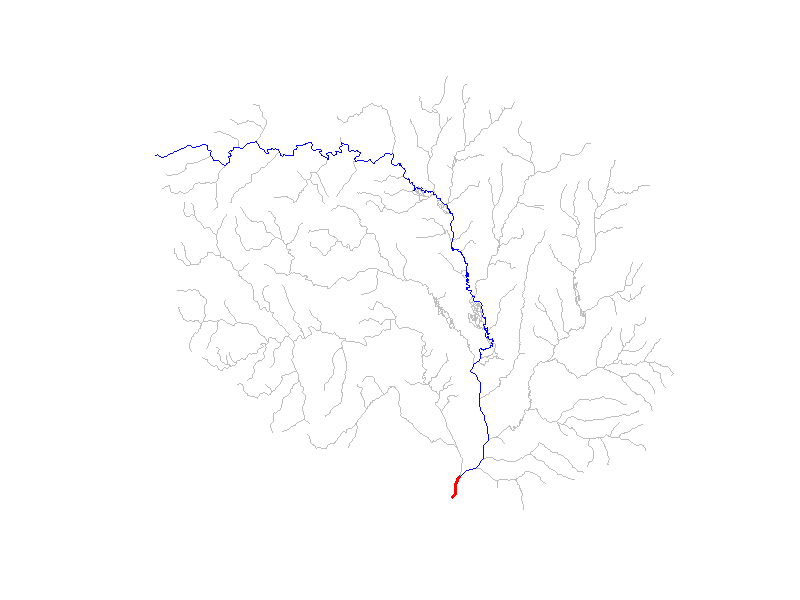
Summary
This entire process of sorting the network and building hydrosequence,
levelpath, and derivative variables is wrapped in the
add_plus_network_attributes() function to provide performance and
simplicity. It supports paralellization and will print status updates in
the case when the input network is very large.
add_plus_network_attributes() returns NHDPlus attribute names
(truncated per shapefile rules as is done in the NHDPlus database).
The terminalpa, levelpathi, dnlevelpat, and dnhydroseq
attributes are hydroseq identifiers as is the convention in NHDPlus,
not primary identifiers (comids) as is returned from the base
functions demonstrated above.
As of 2/2022, this function does not support the up level path
(uplevelpat) or up hydrosequence (uphydroseq) noted in “Other
Derived Network Attributes”.
head(add_plus_network_attributes(dplyr::select(fpath, comid, tocomid, lengthkm, areasqkm,
nameID = gnis_id), status = TRUE))
#> Simple feature collection with 6 features and 14 fields
#> Geometry type: LINESTRING
#> Dimension: XY
#> Bounding box: xmin: 1514059 ymin: 1551922 xmax: 1518746 ymax: 1554515
#> CRS: +proj=aea +lat_1=29.5 +lat_2=45.5 +lat_0=23 +lon_0=-96 +x_0=0 +y_0=0 +ellps=GRS80 +towgs84=0,0,0,0,0,0,0 +units=m +no_defs
#> comid tocomid lengthkm areasqkm nameID weight terminalpa hydroseq
#> 1 8897784 0 1.394 3.5973 991039 577.376 1 1
#> 2 8894360 8897784 0.045 0.0126 575.982 1 2
#> 3 8894356 8894360 1.073 0.8622 991037 435.152 1 151
#> 4 8894354 8894356 0.507 0.2772 991037 426.711 1 159
#> 5 8894350 8894354 1.463 1.0737 987350 10.910 1 741
#> 6 8893884 8894350 1.793 2.1402 987350 9.447 1 742
#> levelpathi pathlength dnlevelpat dnhydroseq totdasqkm terminalfl
#> 1 1 0.000 0 0 595.3383 1
#> 2 1 1.394 1 1 591.7410 0
#> 3 1 1.439 1 2 437.1840 0
#> 4 1 2.512 1 151 428.0076 0
#> 5 741 3.019 1 159 10.9800 0
#> 6 741 4.482 741 741 9.9063 0
#> geom
#> 1 LINESTRING (1514515 1553152...
#> 2 LINESTRING (1514541 1553188...
#> 3 LINESTRING (1515465 1553664...
#> 4 LINESTRING (1515773 1554056...
#> 5 LINESTRING (1517098 1554192...
#> 6 LINESTRING (1518746 1554515...

